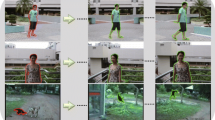Abstract
This paper deals with the use of the segmentation tools and principles presented in [10] and [13] for allowing content-based functionalities. In this framework, means for supervised selection of objects in the scene are proposed. In addition, a technique for object tracking in the context of segmentation-based video coding is presented. The technique is independent of the type of segmentation approach used in the coding scheme. The algorithm relies on a double partition of the image that yields spatially homogeneous regions. This double partition permits to obtain the position and shape of the previous object in the current image while computing the projected partition. In order to demonstrate the potentialities of this algorithm, it is applied in a specific coding scheme so that content-based functionalities, such as selective coding, are allowed.
Résumé
Cet article traite de l’utilisation d’outils de segmentation permettant la mise en place de fonctionnalités liées au contenu. Dans ce cadre, des techniques de sélection supervisée d’objets sont proposées. De plus, une technique de suivi d’objet est présentée. Cette technique est indépendante du type de segmentation utilisée pour le système de codage. L’algorithme repose sur une double partition conduisant ° des régions spatialement homogènes. Cette double partition permet d’obtenir la position et la forme des objets présents dans la trame précédente. L’intérêt de l’algorithme est illustré dans le contexte d’un système de codage sélectif.
Similar content being viewed by others
References
Bouthemy (P.), François (E.). Motion segmentation and qualitative dynamic scene analysis from an image sequence.International Journal of Computer Vision (1993),10, n° 2, pp. 157–182.
MPEO-4 Video Group. mpeo-4 automatic segmentation of moving objects (core experiment n2).In Doc. 1SO/1EC JTC1/ SC29AVG11 MPEG96/84I (March 1996).
mpeo-4 proposal package description (ppd).ISO/1EC JTC1/ SC29/WG1I (July 1995).
Kruse (S.), Kauff (P.). Fine segmentation of image objects by means of active contour models using information derived from morphological transformation.In Visual Communication and Image Processing, Orlando, USA (Apr. 1996), pp. 1164–1172.
Marcotegui (B.). Segmentation de séquences d’images en vue de codage.PhD Thesis, Ecole des Mines de Paris, Fr. (1996).
Marcotegui (B.), Marqués (F.), Morros (R.), Pardàs (M.), Salembier (P.). Segmentation of video sequences and rate control.Ann. Télécommunic. (1997),52, n° 7-8, pp. 380–389.
Marcotegui (B.), Meyer (F.). Bottom-up segmentation of image sequences for coding.Ann. Télécommunic. (1997),52, n° 7-8, pp. 397–407.
Marqués (F.). Motion stability in image sequence segmentation using the watershed algorithm. In P. Maragos, R. Schafer and M. Butt, editors. Mathematical morphology and its applications to image and signal processing, KluwerAcademic Publishers (May 1996), pp. 321-328.
Marqués (F.), Marcotegui (B.), Meyer (F.). Tracking areas of interest for content-based functionalities in segmentation-based video coding.In International Conference on Acoustics, Speech and Signal Processing, ICASSP’96, Atlanta, USA (May 1996), pp. II. 1224–11.1227.
Marqués (F.), Meyer (F.), Pardàs (M.), Salembier (P.). General requirements for coding oriented segmentation of video-sequences.Ann. Télécommunic.(1997),52, n° 7-8, pp. 359–366.
Marqués (F.), Pardàs (M.), Salembier (P.). Coding-oriented segmentation of video sequences. In L. Torres and M. Kunt, editors,Video Coding : The second generation approach, KluwerAcademic Publishers (1996), pp. 79-124.
Meyer (F.), Beucher (S.). Morphological segmentation.Journal of Visual Communication and Image Representation (Sep. 1990),1, n° 1, pp. 21–46.
Meyer (F.), Oliveras (A.), Salembier (P.), Vachier (C). Morphological tools for segmentation: connected operators and watersheds.Ann. Télécommunic. (1997),52, n° 7-8, pp. 367–379.
Pardàs (M.), Salembier (P.). Joint region and motion estimation with morphological tools. In J. Serra and P. Soille, editors,Second Workshop on Mathematical Morphology and its Applications to Signal Processing, Fontainebleau, Fr., KluwerAcademic Press (Sep. 1994), pp. 93–100.
Pardàs (M.), Salembier (P.). Time-recursive segmentation of image sequences. In EURASIP, editor,EUSIPCO 94, VII European Signal Processing Conference, Edinburgh, UK (Sep. 13-16, 1994), pp. 18–21.
Pardàs (M.), Salembier (P.). Segmentation of video sequences for partition tree generation.Ann. Télécommunic. (1997),52, n° 7-8, pp. 389–396.
Pereira (F.). MPEG-4 : a new challenge for the representation of audio-visual information.In Picture Coding Symposium (May 1996).
Salembier (P.). Morphologial multiscale segmentation for image coding.EURASIP Signal Processing (Sep. 1994),38, n° 3, pp. 359–386.
Salembier (P.), Marqués (F.), Pardàs (M.), Morros (R.), Corset (I.), Jeannin (S.), Bouchard (L.), Meyer (F.), Marco-tegui (B.). Segmentation-based video coding system allowing the manipulation of objects.IEEE Trans. on Circuits and Systems for Video Technology (Feb. 1997),7, n° 1, pp. 60–74.
Sezan (I.), Lagendijk (R. L.). Motion analysis and image sequence processing. KluwerAcademic Publishers, Boston (1993).
Tziritas (G.), Labit (C). Motion analysis for image sequence coding.Elsevier Science B. V, The Netherlands (1994).
Author information
Authors and Affiliations
Corresponding authors
Rights and permissions
About this article
Cite this article
Marcotegui, B., Meyer, F. & MarquÉs, F. Allowing content-based functionalities in segmentation-based coding schemes. Ann. Télécommun. 52, 408–415 (1997). https://doi.org/10.1007/BF02998460
Received:
Issue Date:
DOI: https://doi.org/10.1007/BF02998460




